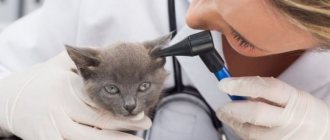Symptoms of ear diseases
Caring owners can detect the onset of the disease in time by periodically checking the condition of their pet’s ears. An independent attempt to diagnose an animal can lead to progression of the disease. If any alarming signs occur, you should consult a doctor.
The following symptoms indicate the occurrence of pathology:
- Discharge. If there is yellow or brown discharge with a strong odor, you need to clean your pet's ears. If this does not help resolve the problem, you need to contact a veterinary clinic.
- Itching. If your cat scratches its ears more than twice a day, it should be examined.
- Hyperemia. The development of pathology is indicated by redness of the animal's ear.
- Edema. Due to the fact that cats' ears are rarely checked, it is difficult to pay attention to swelling. The reason to see a doctor should be a decrease in the free space in the auricle and the diameter of the ear canal.
- Hyperthermia. As the disease progresses, the ears may become hot.
- "Squish" effect. If an animal's ear is dented, the affected ear will make characteristic squelching sounds.
- Head tilt. When ear disease develops, the pet tilts its head in the direction from which it feels discomfort.
Severe itching is one of the symptoms of ear disease.
Parasites
It is no secret that cats are kept in different conditions at home. Some owners do not let them outside, others allow them to move freely. And those cats that are often outdoors are at risk of picking up ticks.
This is a dangerous, extremely unpleasant parasite that burrows into the surface of the ear and when a cat has spots on its ears, red spots appear. Because he constantly scratches his ears with his paws. In this case, a special medicine helps, which allows you to get rid of the parasite.
Ear diseases in cats
There are several of the most common pathologies of the auricle in cats. In the absence of proper therapy, even due to fungal infection, the animal may lose hearing or die. It is worth considering that some diseases manifest themselves only by the formation of crusts in the absence of any other symptoms.
Allergy
If the cause of the formation of crusts is a food allergy, then the pet needs to be switched to high-quality food and choose a balanced diet. It is important to ensure that the products are fresh and natural. By adjusting the diet, the crusts in the ears of a kitten or adult animal will gradually disappear on their own.
Scabies mite
This pathology is also called otodecosis. It is quickly transmitted from a sick animal to a healthy one and is characterized by damage to the auricle by mites.
With odecosis, the animal's ears are covered with a dark coating with a pungent odor.
The inside of your pet's ears become covered with a dark coating with a pungent odor, and severe itching is observed.
If left untreated, the mite moves deeper and affects the inner ear.
Dermatitis and eczema
Dermatitis is often the result of allergies, eczema, or damage to the animal’s body by parasites. The formation of scabs and wet ulcers, itching, and accumulation of discharge with an unpleasant odor are observed. The disease is not dangerous for healthy cats. Therapy consists of eliminating the root cause and subsequent local treatment of the affected area.
We recommend this article:
Basic types and rules for treating eczema in cats
Necrosis of the auricle
Causes of pathology:
- infection of an existing wound on the ear;
- severe injury, prolonged compression of tissue, frostbite, cut;
- spread of the existing purulent process to the auricle.
In the affected organ, blood circulation is disrupted, and tissue begins to rot and die. This is often observed in cats that live outside or spend a lot of time in the cold. The solution to the problem is complete or partial amputation.
Neoplasms
A benign or malignant tumor can form in the purr's ear: papilloma, fibroma, sarcoma. The ear canal is gradually blocked, and the coordination of the animal’s movements is disrupted. Pathology requires surgical intervention.
Hematoma
Occurs as a result of injury, bite, scratching or any other strong mechanical impact. The auricle swells, turns red, and becomes hot. Severe pain syndrome develops. The animal becomes restless and shakes its head. In the clinic, the hematoma is opened and the contents are cleaned out. An ointment is placed inside, for example, “Levomekol”. The procedure is repeated until the symptoms are completely eliminated.
Hematoma occurs as a result of injury
Ulcers
Wounds in a cat's ears indicate a fungal infection. In this case, the formation of small wounds, pimples, blisters with pus or yellow liquid is observed. After they burst, scabs appear.
In this case, you cannot use ointment. At the clinic, a scraping will be taken from the animal to determine the causative agent of the disease and select a drug to which the pathogens are sensitive. To dry the ulcers, Streptocide powder is used.
Inflammatory processes, otitis media
Causes of the disease:
- tick damage;
- formation of neoplasms;
- ear getting wet;
- injury;
- infection.
The main symptoms of damage to the outer ear are itching and excessive production of wax. If the inflammatory process spreads deeper, the pet experiences pain and shakes its head. There is the release of purulent exudate with an unpleasant odor and hyperthermia. The cat's body temperature may rise. The animal is prescribed antibiotics and local treatment of the affected areas.
Lymphextravasate
Can develop as a result of any injury. Characterized by the accumulation of large amounts of lymph under the skin. Lymphatic extravasation does not pose a threat to the life and health of the pet. For a long time there are no external signs of pathology, there is no hyperthermia. As part of the therapy, accumulated lymph is pumped out with a syringe in a veterinary clinic. Sometimes it is necessary to completely open the resulting cavity, after which sutures are applied.
Eczema
In eczema, red spots on a cat's ear are caused by water, a chemical, or a foreign object getting into the ear. Provocateurs are also:
- External irritants (chafing collar, contact with rough fabric, etc.);
- Allergic reactions of the immune system to individually intolerable components (for example, food);
- Fungi, bacteria, as well as fleas and other parasites;
- Irritating substances (shampoos, dyes, household chemicals, etc.);
- Seborrhea (dandruff);
- Chronic stress;
- Diseases of internal systems and organs (gastrointestinal tract, liver, kidneys, etc.);
- Hormonal disorders;
Eczema can be dry or weepy.
The first form is characterized by the absence of infection in the affected areas. The surface epithelium undergoes keratinization and becomes covered with dry scales and tubercles.
The second type is caused by fungi, viruses and bacteria of a pyogenic nature entering the body. With weeping eczema, the blistering rashes open on their own, and the tissues adjacent to the affected areas soften and constantly secrete exudate. Eczema becomes chronic 3-6 weeks after the onset of its development. It is characterized by absolute dryness of the skin and atrophy of the hair follicles.
You might be interested in: What causes a cat's eyes to fester?
Diagnostic methods
To choose the right treatment, you need to accurately determine the diagnosis. The following methods are used for this:
- general examination;
- scraping;
- microbiological study of hair roots during the formation of bald patches;
- general and biochemical blood test;
- Ultrasound, x-ray if the formation of a neoplasm is suspected.
If your cat is in pain, it will be difficult to examine him. It is important to follow all safety precautions during examination in case the disease could be dangerous to humans.
General examination Scraping General and biochemical blood test
Lichen
This disease is already dangerous for humans, so if spots with round rings around them appear on the ears, and then they spread to other parts of the animal’s body, cutting off large areas of fur, there can be no doubt – this is ringworm. A rather unpleasant skin disease of fungal origin is transmitted to humans, so the following precautions must be observed :
- carry out a thorough cleaning of the apartment using disinfectants;
- disinfection is carried out only with rubber gloves;
- the cat should be isolated during the illness.
© shutterstock
The veterinarian prescribes special medications that have an antifungal effect, their use leads to the fact that the disease disappears, and the danger for cats of becoming bald is completely eliminated. It is also important that a person is safe when treating lichen, since it can also appear in people.
Effective Treatments
Therapy is selected based on the diagnostic results and the identified cause of the pathology:
- Allergy. Changing your pet's diet, changing food.
- Mite. It is recommended to bury the ears with Tsipam or Stronghold drops. It is important to regularly carry out hygiene procedures, cleansing the affected skin of dark plaque.
- Lichen. Requires immediate treatment. Sulfur ointment or “Yam” remedy is prescribed. It is important to be careful until your pet recovers so that the disease does not spread to people.
- Hematoma, neoplasm. Surgical intervention is performed with further local treatment of the wound.
We recommend this article:
How to recognize and properly treat ringworm in a cat
We recommend this article:
Characteristic symptoms of allergy to cats, diagnosis and treatment of pathology
Demodicosis
This is a dangerous invasive disease caused by the bites of microscopic ticks. Cats often suffer from this disease during the warm season, when the parasites are at their most active.
Symptoms of demodicosis include:
- the formation of dense tubercles on the pet’s body, when pressure is applied to them, white clots are released;
- constant scratching and skin rashes;
- redness of the affected areas;
- partial baldness;
- presence of red crusts;
- formation of pustules during the duration of the disease.
Treatment of cats for demodicosis involves the use of antiparasitic agents (lotions, shampoos, collars, powders), injections and treatment of affected areas with anti-inflammatory drugs.
How to prevent the development of the disease
Ear diseases are common among cats. There are a number of simple rules to avoid the development of pathology:
- Regular examination of your pet's ears and careful cleaning.
- Avoiding hypothermia, frostbite, and getting your ears wet.
- Proper nutrition.
- Timely vaccination. This is especially important if your pet goes outside.
- Limit contact with other animals if the cat is indoor and does not go outside.
Timely vaccination is a way to prevent the development of diseases.
A purring fluffy is not a toy, but a living creature, and every cat owner is responsible for his pet. If any changes in the animal's behavior occur, it should be examined and consulted with a doctor.
Recommended Posts
How to cure demodicosis in a dog and save your pet’s life
Basic symptoms and rules for treating cystitis in cats
Causes and methods of treating acne in cats
The first symptoms and features of treatment of piroplasmosis in dogs
Possible causes, methods of diagnosis and treatment of black feces in cats
Symptoms and popular treatments for staphylococcus in dogs
Hematomas and abscesses
Both of these ailments are the result of trauma to the animal. In general, their symptoms are similar, as are the reasons why they appear in a cat. Often, without proper treatment, a hematoma can develop into an abscess.
Cats that are let outside by their owners often suffer mechanical damage to the ear. This can be especially observed with the onset of spring, when cats fight for the attention of cats, or simply do not divide the territory. The pet returns home with various injuries, both open wounds and bruises.
Other Features
- Seasonal shedding, in which dogs shed excess hair to facilitate thermoregulation. It is possible that shedding began precisely in the ear area.
- Thermal injuries (burns, frostbite) disrupt the structure of the skin, and it begins to peel off, thus getting rid of the damaged areas. The ears also become red.
- Lack of protein, which makes up any tissue of a living organism. If a pet leads an active lifestyle, its need for protein is higher. To restore muscles and bone tissue, in the absence of a sufficient amount of protein in food, it will destroy what it considers unnecessary tissue, converting it into nutrients.
- Deficiency of calcium and fiber, which also makes up the skin. Not only for construction, but also for maintaining all tissues, resources are needed.
- Stress. The fact is that the elements of the nervous system also consist of protein, calcium, sodium, fluorine and iron. Some elements are synthesized in a dog’s body in limited quantities and are used to restore the nervous system after stressful situations. Thus all tissues are deficient. The central nervous system has the highest priority among all systems, since it is a kind of “boss” of the body.
- Peeling can be caused by microclimatic conditions. If the house has air conditioning and it’s hot outside, the dog’s body will perceive this as a sharp change in the temperature of the environment and adapt its skin to protect itself. Some breeds are especially susceptible to this factor.
- In puppies during the period of active growth, peeling is observed due to the restructuring of the epidermal layer. New hairs are born in it, sebaceous glands are formed, and neural connections between receptors and skin are established. This changes the integrity of the cover, forming microtraumas that become covered with a fine crust, similar to a husk for us.
These tips will help not only with skin diseases, but also with strengthening overall health and immunity.
Examples of photos of peeling inside and outside the ears of dogs:
Psychogenic alopecia
Alopecia is the rapid loss of hair. The cause of psychogenic alopecia in domestic cats is neurosis that occurs as a result of environmental changes (change of residence, new owner, appearance of a new family member or pet in the house, etc.).
Most often, this disease occurs in emotional breeds: Siamese, Himalayan, Burmese, Abyssinian, but it also happens in completely outbred individuals. Externally, the disease manifests itself as baldness in the groin area, abdomen, sides and inner thighs, along the dorsal midline. There is no redness or crusts on the bald areas.
In the treatment of psychogenic alopecia, the main thing is to eliminate or minimize stress. Among the medications, behavior-correcting drugs have proven themselves: Amitriptyline, Cat Bayun or Stop Stress.
Cushing's syndrome
Cushing's syndrome (or hyperadrenocorticism) is an extremely rare disease that develops as a result of excessive amounts of the hormone cortisol in the body. Excess cortisol can occur with the use of large amounts of corticosteroids orally, locally or by injection, with tumors of the adrenal cortex, and also as a result of pituitary gland disease.
The following phenomena are observed in Cushing's syndrome:
- increased thirst and increased urination;
- voracity;
- enlarged abdomen;
- amyotrophy;
- lethargy;
- hair loss;
- thinning of the skin.
In the treatment of this serious disease, as a rule, the drug Trilostane is used, which suppresses the production of cortisol. In some cases, removal of the adrenal gland or pituitary gland may be necessary, as well as radiation therapy to the pituitary tumor.
Sarcoptosis is a disease caused by microscopic mites of the genus Sarcoptes that parasitize the skin of domestic animals. More common in dogs.
Important. Sarcoptes mites are a category of parasites that can be transmitted from cats to humans. Having transferred to human skin, they are unable to reproduce and die. Despite this, when coming into contact with an infected animal, the owner runs the risk of getting pseudoscabies with characteristic symptoms such as rash, redness and itching. Symptoms persist for up to 4 months.
The clinical picture of sarcoptic mange is similar to other diseases: the affected areas dry out and cause itching, subsequently the hair falls off in these areas, and scabs form unattractive ulcers.
We recommend reading: Pyometra in Dogs Treatment After Surgery
In the fight against Sarcoptes ticks, Stronghold drops, which are applied to the animal’s withers, have proven themselves to be effective.
We invite you to read an article about the feline disease sarcoptic mange.
Notoedres is another parasitic disease caused by mites of the genus Notoedres cat.
Symptoms of this disease include:
- severe itching;
- blisters are observed on the face, ears, stomach and groin area, which become crusty after scratching;
- hair loss, often in places where crusts are concentrated;
- as the disease progresses, the skin thickens, dries and cracks - as a result, the wounds open the gates to infections (bacteria, fungi and viruses).
Therapy for notoedrosis includes bathing with acaricidal and keratolytic shampoos, as well as local application of medications (Demos, aversectin ointment, neocidol aqueous emulsion, sulfur ointment, Stronghold).
Notoedres is another parasitic disease caused by mites of the genus Notoedres cat.
Other causes of redness
Red, almost dark spots on the ears can occur not only due to the manifestation of any disease. There are also natural options for the occurrence of such spots on the ears.
- Contamination of the ears, resulting in the formation of wax plugs, they must be cleaned at least twice a week using cotton swabs and sunflower oil.
- In winter, spots appear after a walk, this is evidence of frostbite.
These reasons are the most harmless, which indicate that the pet is healthy.
Love for their pet forces good owners to closely monitor the well-being of the cat. If red spots on your cat's ears suddenly begin to appear, causing him discomfort, you should immediately consult a veterinarian.
Dermatitis
The cat's ears on the head turn red as a result of simple dermatitis, which occurs when the mechanical ones are damaged. When any scratches, burns, etc. appear. In this case, red spots are also noticed near the ears.
In fact, this is an elementary inflammation that is treated with the most common anti-dermatosis drugs. As you can see, a cat’s ears turn red for various reasons, but treatment is always necessary, since otherwise the disease will be neglected and lead to dire consequences.











